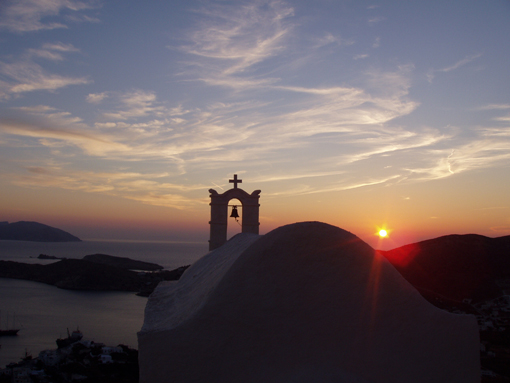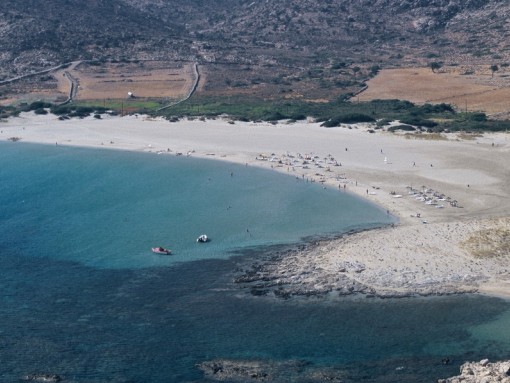 Ios means “flower”. Did you know that?
Ios means “flower”. Did you know that?Íos or Niós, as the locals call it, is one of the most beautiful islands of the Cyclades, like a flower, as its name “Ion” denotes. According to the ancient tradition, Íos was the homeland of Homer’s mother and the final resting place of the great epic poet.

Find out!
Upon reaching the island, the view before you is enchanting: as pretty as a picture, Hóra lies very close to the harbour in Ormos and greets the travellers, built in an amphitheatre-like manner on the slope of a hill, on the top of which there are ruins of a mediaeval castle. This is a listed traditional village, one of the finest examples of Cycladic architecture. Snow-white little houses, picturesque arcade-covered alleys (“stiyádia”), the twelve windmills, churches with arched belfries and light blue domes create a unique residential area. Hóra’s sheltered alleys is the “stage” where Koúnia, an ancient local custom is performed every May, as follows: young men make swings for young ladies who rock themselves while listening to traditional love songs being sung to them in the form of a dialogue.
The most important of Íos’ 365 churches is Panayia Gremiótissa, standing on Hóra’s highest spot. It is built literally on the edge of a cliff, affording an amazing view of the open sea. This place is the centre of one of the biggest religious feasts on the island, taking place on August 15, and involving a procession in Hóra with the icon of the Mother of God placed at the forefront. Later on, a traditional festival takes place with local island-style singing and dancing till dawn!
Skárkos, an early Cycladic period settlement, (2,800 BC) denotes the significant presence of man registered as far back as the early antiquity. The exemplary restoration and promotion of this archaeological site has been awarded a prize. A rich collection of finds from the settlement as well as antiquities going back to the island’s historical course are on display in Hóra’s excellent Archaeological Museum.
Palaiókastro stands on the northeast side of the island and used to be a fort during the Byzantine period, useful for controlling the seaways from Constantinople down to Crete. It communicated via visual signals and fires with castles in Naxos, Amorgos and Santorini.
Explore!
Mylopótas, Magganári, Psáthi, Yialós, Kálamos and Ayia Theodóti beaches are known worldwide –among others– to be top choices for dives in the island’s emerald waters. In order to explore the inland, follow the paths that shepherds prefer to take (Ayia Theodóti-Hóra, Ayia Eirini-Valmás Beach, Hóra-Pýrgos-Psáthi, Hóra -Ayios Spyridonas-Perivólia-Ayios Prókopas-Pelekaniá) and discover the pristine natural beauty of Íos through magic scents and colours.

Taste!
A feast of local tastes awaits the lucky visitors: chickpea balls, sun-dried picarel –a taste of the Aegean Sea–, tsimétia (stuffed vegetable marrow flowers), vegetable marrow omelette, dolmadákia using fresh vine leaves from the numerous vineyards where the famed niotiko (i.e. from Ios island) wine is produced. Try also soúgli with tsiarídes (traditional breakfast), panáda (home-made bread sopped in red sauce – an ideal snack!), and goat soup. For desert try the local pumpkin pie made of sweet pumpkin, Mosénta (watermelon pie) and pastotá figs (dried figs with sesame seeds).
Don’t leave without getting some of the local cheeses like skotíri (soft goat cheese with herbs), local kefalotýri (hard salty yellow cheese) and myzíthra (soft white creamy, almost sweet cheese) as well as some of the excellent thyme honey, pastélia (honeyed sesame bars), watermelon confiture, myzithra pie and pomegranate liqueur.
Getting there
There is a ferry and speedboat connection with Piraeus and Rafina, Iráklion and Rethymno as well as with the rest of the Cyclades islands. Furthermore, the modern, well equipped heliport is open, in case you need this service.
Content by www.visitgreece.gr © GNTO